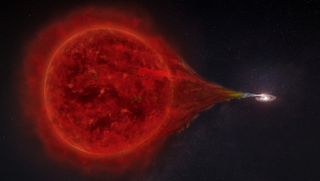Violent stellar explosion produces highest-energy gamma-rays ever observed from a nova
They had an astonishing energy value of 250 gigaelectronvolts — some of the highest ever measured in a nova.

A small, dense star chowing down on its enormous dying neighbor caused a massive explosion that generated some of the highest-energy gamma-rays ever observed for a nova.
The nova system, called RS Ophiuchi, produced the extremely high-energy gamma-rays during its latest thermonuclear explosion, observed by astronomers at the Max Planck Institute for Physics in Munich in August 2021.
Located 5,000 light-years away from Earth in the constellation Ophiuchus, RS Ophiuchi comprises one red giant star and one white dwarf that exist in a parasitic relationship called a recurrent nova system. The dense white dwarf absorbs hydrogen gas shed from the red giant's outer later, eventually acquiring so much material that the white dwarf overheats and erupts in a massive thermonuclear explosion called a nova. This occurs cyclically in recurrent nova systems, and for RS Ophiuchi, a cycle lasts approximately 15 years.
Supernova photos: Great images of star explosions
The team of astronomers observed RS Ophiuchi's most recent nova using the dual Major Atmospheric Gamma Imaging Cherenkov (MAGIC) telescopes in Spain's Canary Islands, which revealed the presence of highly energetic gamma-rays with a value of 250 gigaelectronvolts (GeV) — among the highest energies ever recorded for a nova.
The explosion created shock waves that accelerated particles to nearly the speed of light. Based on these observations, scientists now theorize that "gamma-rays emanate from energetic protons, nuclei of hydrogen atoms," the researchers said in a statement.
"This also makes nova outbursts a source of cosmic rays," which are highly energetic particles that travel through space at nearly the speed of light, David Green, a scientist at the Max Planck Institute for Physics who co-authored a paper on the observations, said in the statement. "However, they tend to play the role of local heroes — meaning to only contribute to the cosmic rays in the close neighborhood. The big players for cosmic rays are supernova remnants. The shock fronts created from stellar explosions are far more violent compared to novas."
Get the Space.com Newsletter
Breaking space news, the latest updates on rocket launches, skywatching events and more!
Astronomers will continue to look for similar violent systems throughout the galaxy to further study the interplay within them. The team's observations were published April 14 in the journal Nature Astronomy.
Follow Stefanie Waldek on Twitter @StefanieWaldek. Follow us on Twitter @Spacedotcom and on Facebook.
Join our Space Forums to keep talking space on the latest missions, night sky and more! And if you have a news tip, correction or comment, let us know at: community@space.com.

Space.com contributing writer Stefanie Waldek is a self-taught space nerd and aviation geek who is passionate about all things spaceflight and astronomy. With a background in travel and design journalism, as well as a Bachelor of Arts degree from New York University, she specializes in the budding space tourism industry and Earth-based astrotourism. In her free time, you can find her watching rocket launches or looking up at the stars, wondering what is out there. Learn more about her work at www.stefaniewaldek.com.
